Analyzing the Mechanism of Zinc Oxide Nanowires Bending and Bundling Induced by Electron Beam under Scanning Electron Microscope Using Numerical and Simulation Analysis
Abstract
:1. Introduction
2. Zinc Oxide Nanowires Fabrication (Experimental)
3. Zinc Oxide Nanowires under Scanning Electron Microscope
4. Modeling and Simulation Analysis of the Fabricated Structure
4.1. Numerical Analysis
4.2. The Effect of Nanowire Length and Surface Charge Density on the Total Nanowire Deflection
4.3. Absorption in the Visible and Near Infrared Regions
4.4. Effect of Bent Nanowires Concentration on the Absorpance
4.5. Enhancing the Absorption Using Plasmonic NPs
5. Conclusions
Author Contributions
Funding
Institutional Review Board Statement
Informed Consent Statement
Data Availability Statement
Conflicts of Interest
References
- Gao, P.; Wang, Z.Z.; Liu, K.H.; Xu, Z.; Wang, W.L.; Bai, X.D.; Wang, E.G. Photoconducting response on bending of individual ZnO nanowires. J. Mater. Chem. 2009, 19, 1002–1005. [Google Scholar]
- Gupta, M.; Dhawan, P.K.; Verma, S.K.; Yadav, R.R. Diameter dependent ultrasonic characterization of InAs semiconductor nanowires. Open J. Acoust. 2015, 5, 2018–2225. [Google Scholar] [CrossRef] [Green Version]
- Fan, Z.; Lu, J.G. Gate-Refreshable nanowire chemical sensors. Appl. Phys. Lett. 2005, 86, 123510. [Google Scholar] [CrossRef]
- Wang, Z.L. Nanopiezotronics. Adv. Mater. 2007, 19, 889–892. [Google Scholar]
- Liu, Q.; Nie, Y.; Shang, J.; Kou, L.; Zhan, H.; Sun, Z.; Bo, A.; Gu, Y. Exceptional deformability of wurtzite zinc oxide nanowires with growth axial stacking faults. Nano Lett. 2021, 21, 4327–4334. [Google Scholar]
- Guo, N.; Xiao, L.; Gong, F.; Luo, M.; Wang, F.; Jia, Y.; Chang, H.; Liu, J.; Li, Q.; Wu, Y.; et al. Light-Driven WSe2-ZnO junction field-effect transistors for high-performance photodetection. Adv. Sci. 2020, 7, 1901637. [Google Scholar] [CrossRef] [Green Version]
- Fan, Q.; Li, D.; Li, J.; Wang, C. Structure and piezoelectricity properties of V-doped ZnO thin films fabricated by sol-gel method. J. Alloy. Compd. 2020, 829, 154483. [Google Scholar]
- Drici, A.; Djeteli, G.; Tchangbedji, G.; Derouiche, H.; Jondo, K.; Napo, K.; Bernède, J.C.; Ouro-Djobo, S.; Gbagba, M. Structured ZnO thin films grown by chemical bath deposition for photovoltaic applications. Phys. Status Solidi A 2004, 201, 1528–1536. [Google Scholar]
- Matsubara, K.; Fons, P.; Iwata, K.; Yamada, A.; Sakurai, K.; Tampo, H.; Niki, S. ZnO Transparent conducting films deposited by pulsed laser deposition for solar cell applications. Thin Solid Films 2003, 431–432, 369–372. [Google Scholar] [CrossRef]
- Lee, J.H.; Lee, W.J.; Lee, S.H.; Kim, S.M.; Kima, S.; Jang, H.M. Atomic-scale origin of piezoelectricity in wurtzite ZnO. Phys. Chem. Chem. Phys. 2015, 17, 7857–7863. [Google Scholar] [PubMed] [Green Version]
- Soni, A.; Mavani, K.R. Controlling porosity and ultraviolet photoresponse of crystallographically oriented ZnO nanostructures grown by pulsed laser deposition. Scr. Mater. 2018, 162, 24–27. [Google Scholar] [CrossRef]
- Wang, Z.L.; Wu, W.; Falconi, C. Piezotronics and piezo-phototronics with third-generation semiconductors. MRS Bull. 2018, 43, 922–927. [Google Scholar] [CrossRef] [Green Version]
- Umar, A.; Ribeiro, C.; Al-Hajry, A.; Masuda, Y.; Hahn, Y.B. Growth of highly c-axis-oriented ZnO nanorods on ZnO/glass substrate: Growth mechanism, structural, and optical properties. J. Phys. Chem. C 2009, 113, 14715–14720. [Google Scholar] [CrossRef]
- Baruah, B.; Kelley, C.; Djokoto, G.; Hartnett, K. Polymer-capped gold nanoparticles and ZnO nanorods form binary photocatalyst on cotton fabrics: Catalytic breakdown of dye. Front. Mater. Sci. 2021, 15, 431–447. [Google Scholar] [CrossRef]
- Zeng, H.; Cai, W.; Liu, P.; Liu, P.; Xu, X.; Zhou, H.; Klingshirn, C.; Kalt, H. ZnO-based hollow nanoparticles by selective etching: Elimination and reconstruction of metal-semiconductor interface, improvement of blue emission and photocatalysis. ACS Nano 2008, 2, 1661–1670. [Google Scholar] [CrossRef]
- Gargas, D.; Gao, H.; Wang, H.; Wang, H.; Yang, P. High quantum efficiency of band-edge emission from ZnO nanowires. Nano Lett. 2011, 11, 3792–3796. [Google Scholar]
- Yang, T.; Huang, L.; Harn, Y.; Harn, Y.; Lin, C.; Chang, J.; Wu, C.; Wu, J. High density unaggregated Au nanoparticles on ZnO nanorod arrays function as efficient and recyclable photocatalysts for environmental purification. Small 2013, 9, 3169–3182. [Google Scholar]
- Baruah, B.; Downer, L.; Agyeman, D. Fabric-based composite materials containing ZnO-NRs and ZnO-NRs-AuNPs and their application in photocatalysis. Mater. Chem. Phys. 2019, 231, 252–259. [Google Scholar]
- Wen, C.; Liao, F.; Liu, S.; Kang, Z.; Zhang, X.; Shao, M. Bi-functional ZnO-RGO-Au substrate: Photocatalysts for degrading pollutants and SERS substrates for real-time monitoring. Chem. Commun. 2013, 49, 3049–3051. [Google Scholar]
- Zhu, L.; Phillips, M.R.; Ton-That, C. Coalescence of ZnO nanowires grown from monodispersed Au nanoparticles. CrystEngComm 2015, 17, 4987–4991. [Google Scholar]
- ElZein, B.; Yao, Y.; Barham, A.S.; Dogheche, E.; Jabbour, G.E. Toward the growth of self-catalyzed ZnO nanowires perpendicular to the surface of silicon and glass substrates, by pulsed laser deposition. Materials 2020, 13, 4427. [Google Scholar] [CrossRef]
- ElZein, B.; Boulfrad, S.; Jabbour, G.E.; Dogheche, E. Parametric study of self-forming ZnO nanowall network with honeycomb structure by pulsed laser deposition. Appl. Surf. Sci. 2014, 292, 598–607. [Google Scholar] [CrossRef]
- El Zein, B.; Yao, Y.; Dogheche, E.; Boulfrad, S.; Jabbour, G. Nanometer Sized Structures Grown by Pulsed Laser Deposition. Patent Number: US20150280017A1, 29 October 2013. [Google Scholar]
- Park, S.K.; Gao, X.L. Bernoulli–Euler beam model based on a modified couple stress theory. J. Micromech. Microeng. 2006, 1, 2355. [Google Scholar] [CrossRef]
- Elrashidi, A. Light harvesting in silicon nanowires solar cells by using graphene layer and plasmonic nanoparticles. Appl. Sci. 2022, 12, 2519. [Google Scholar] [CrossRef]
- Elrashidi, A.; Elleithy, K. High performance polymer solar cells using grating nanostructure and plasmonic nanoparticles. Polymers 2022, 14, 862. [Google Scholar] [CrossRef] [PubMed]
- Kao, C.; Chen, F.; Liao, C.; Huang, M.; Hus, C. Plasmonic-enhanced performance for polymer solar cells prepared with inverted structures. Appl. Phys. Lett. 2012, 101, 193902. [Google Scholar] [CrossRef] [Green Version]
- Liu, F.; Qu, D.; Xu, Q.; Pan, X.; Cui, K.; Feng, X.; Zhang, W.; Huang, Y. Efficiency enhancement in organic solar cells with extended resonance spectrum of localized surface plasmon. IEEE Photonics J. 2017, 5, 8400307. [Google Scholar]


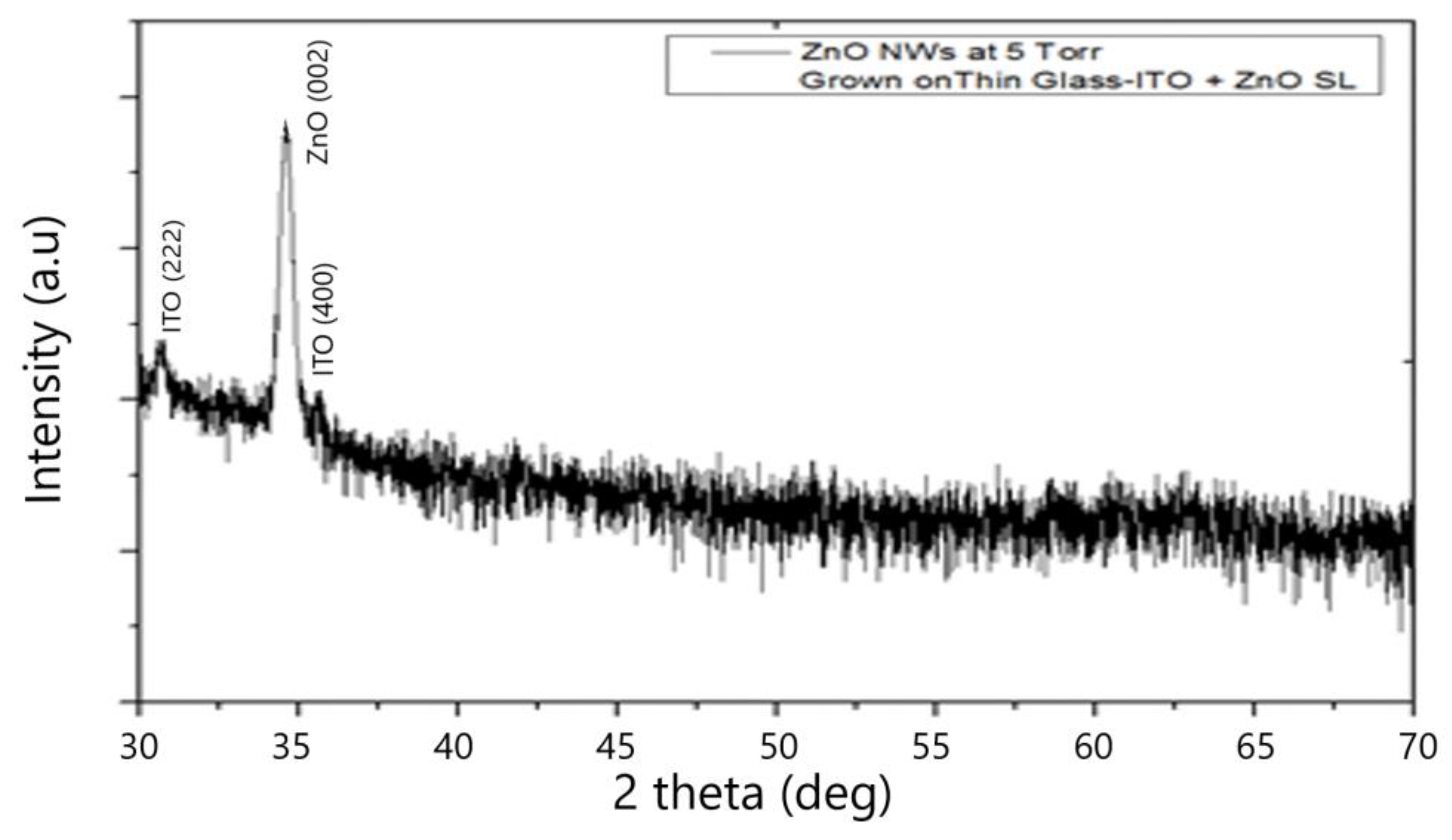

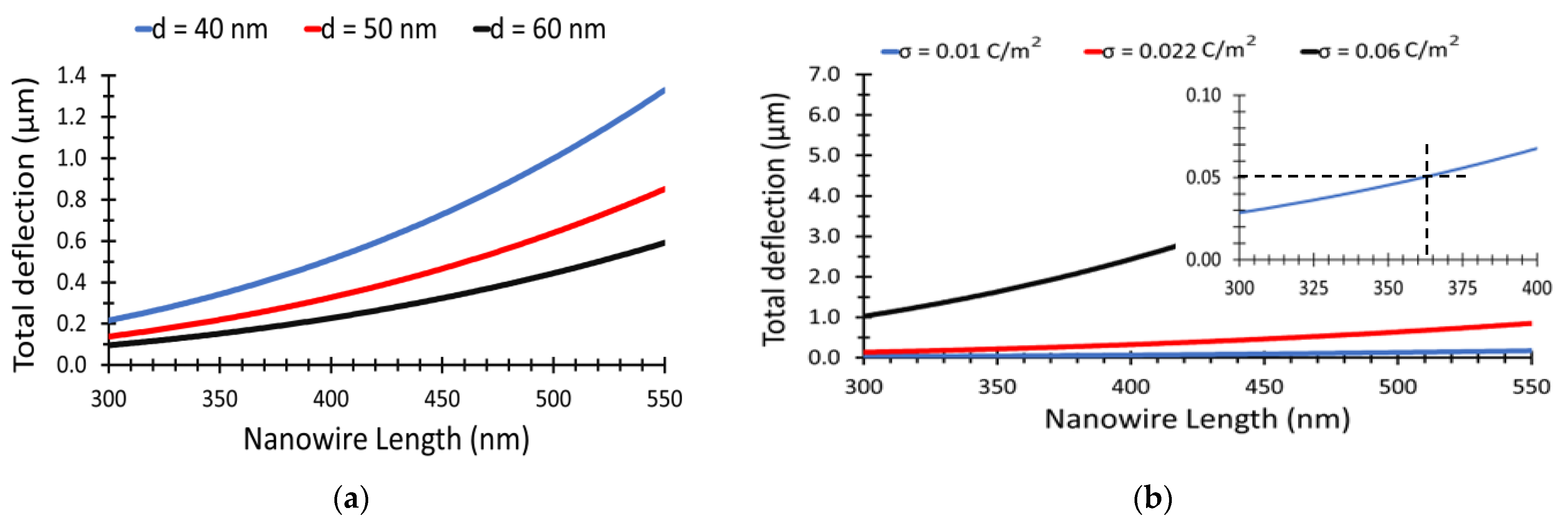


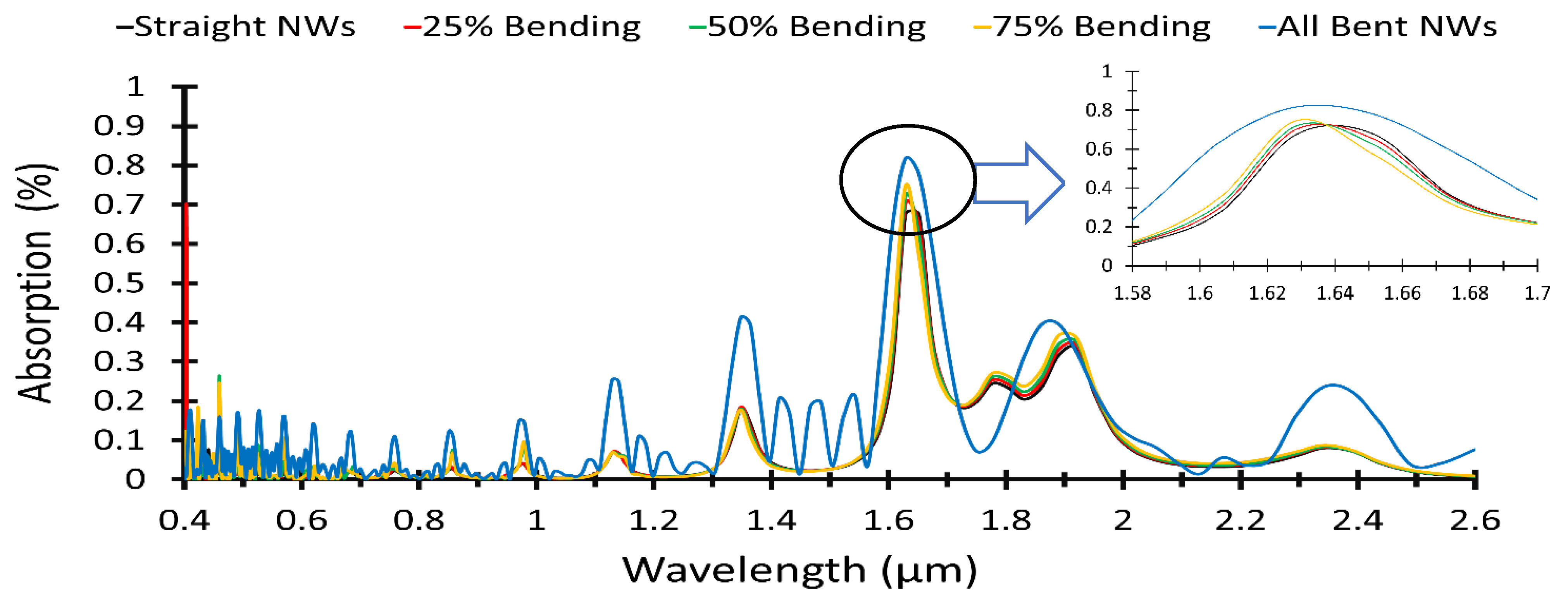
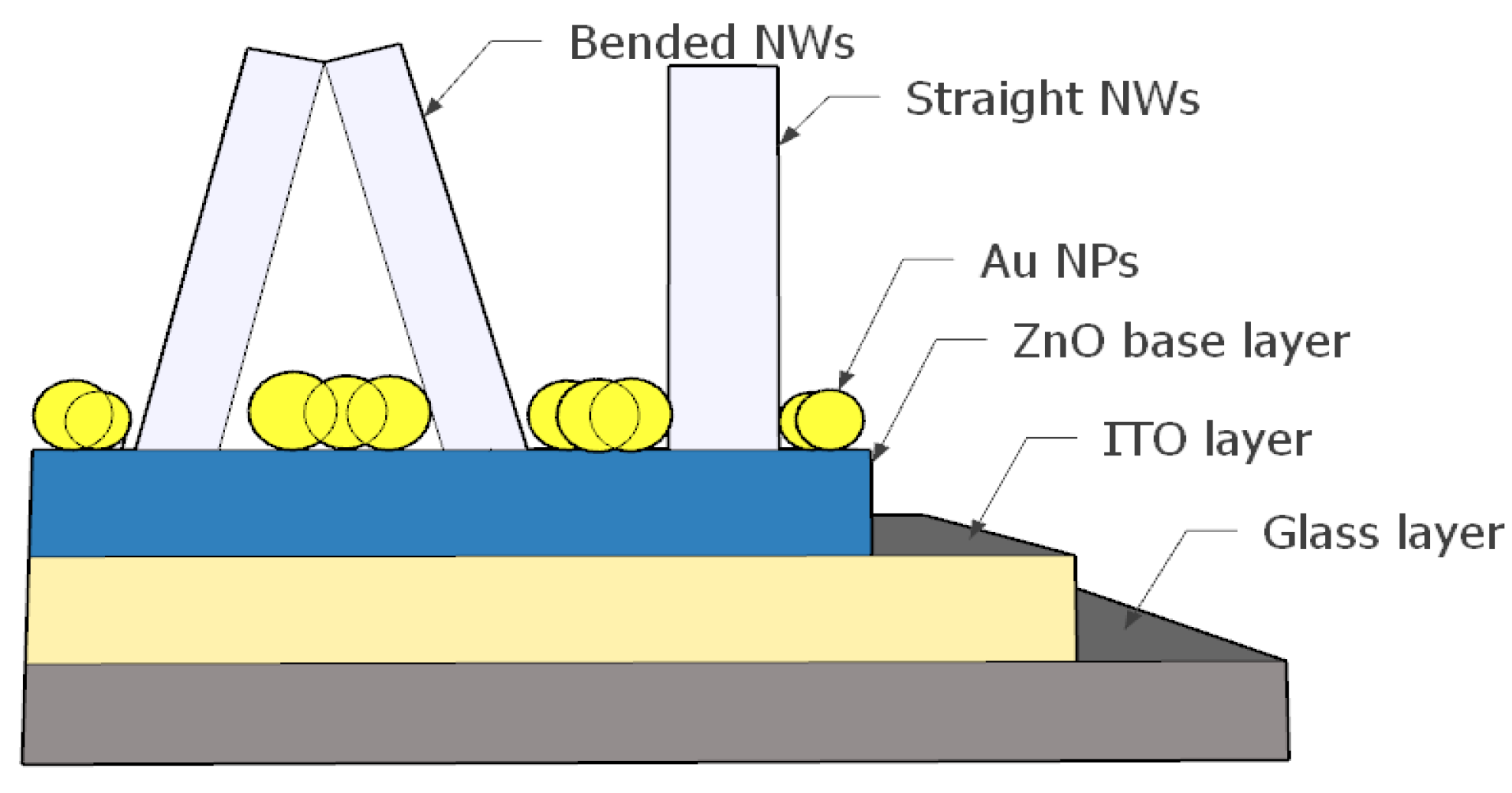
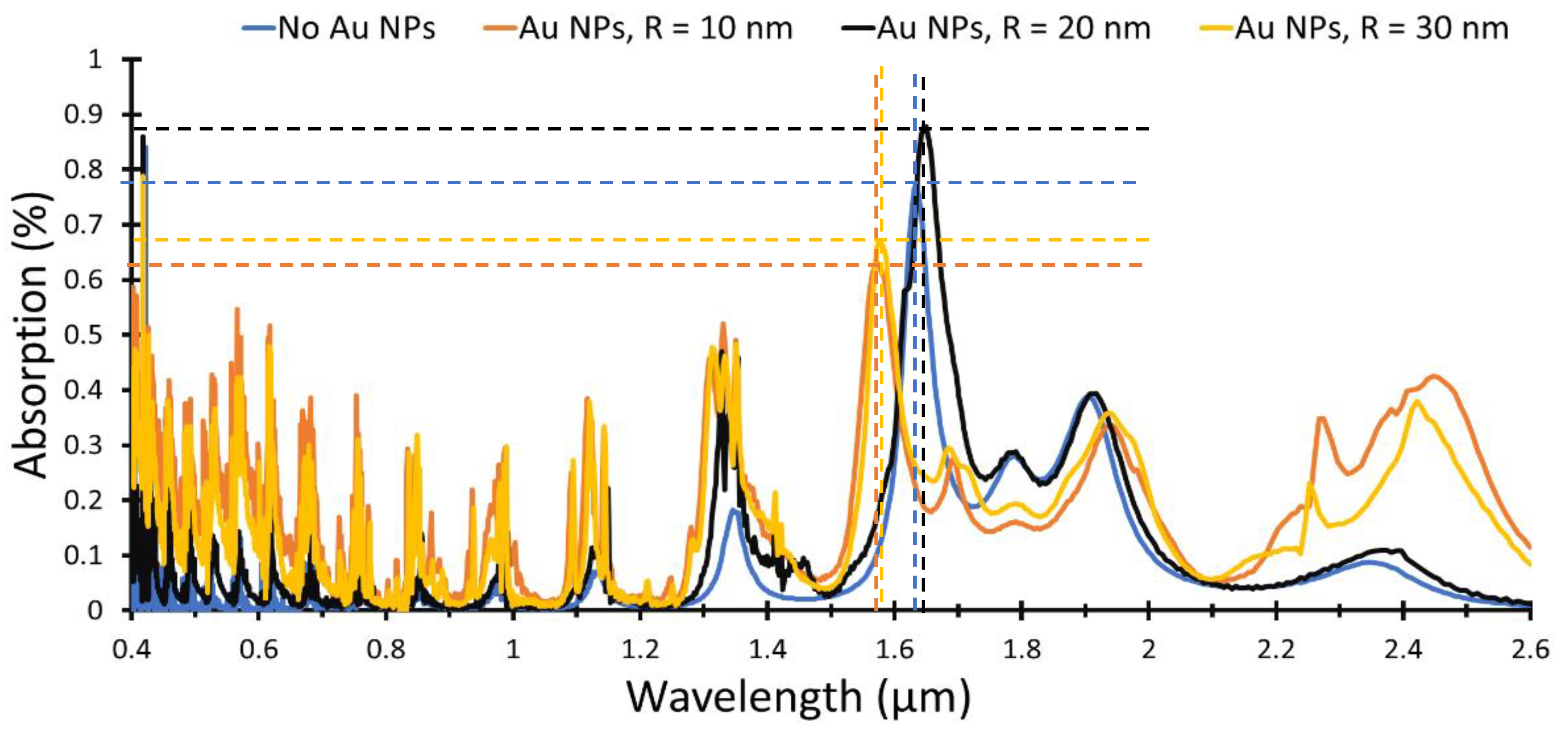
Publisher’s Note: MDPI stays neutral with regard to jurisdictional claims in published maps and institutional affiliations. |
© 2022 by the authors. Licensee MDPI, Basel, Switzerland. This article is an open access article distributed under the terms and conditions of the Creative Commons Attribution (CC BY) license (https://creativecommons.org/licenses/by/4.0/).
Share and Cite
ElZein, B.; Elrashidi, A.; Dogheche, E.; Jabbour, G. Analyzing the Mechanism of Zinc Oxide Nanowires Bending and Bundling Induced by Electron Beam under Scanning Electron Microscope Using Numerical and Simulation Analysis. Materials 2022, 15, 5358. https://doi.org/10.3390/ma15155358
ElZein B, Elrashidi A, Dogheche E, Jabbour G. Analyzing the Mechanism of Zinc Oxide Nanowires Bending and Bundling Induced by Electron Beam under Scanning Electron Microscope Using Numerical and Simulation Analysis. Materials. 2022; 15(15):5358. https://doi.org/10.3390/ma15155358
Chicago/Turabian StyleElZein, Basma, Ali Elrashidi, Elhadj Dogheche, and Ghassan Jabbour. 2022. "Analyzing the Mechanism of Zinc Oxide Nanowires Bending and Bundling Induced by Electron Beam under Scanning Electron Microscope Using Numerical and Simulation Analysis" Materials 15, no. 15: 5358. https://doi.org/10.3390/ma15155358







